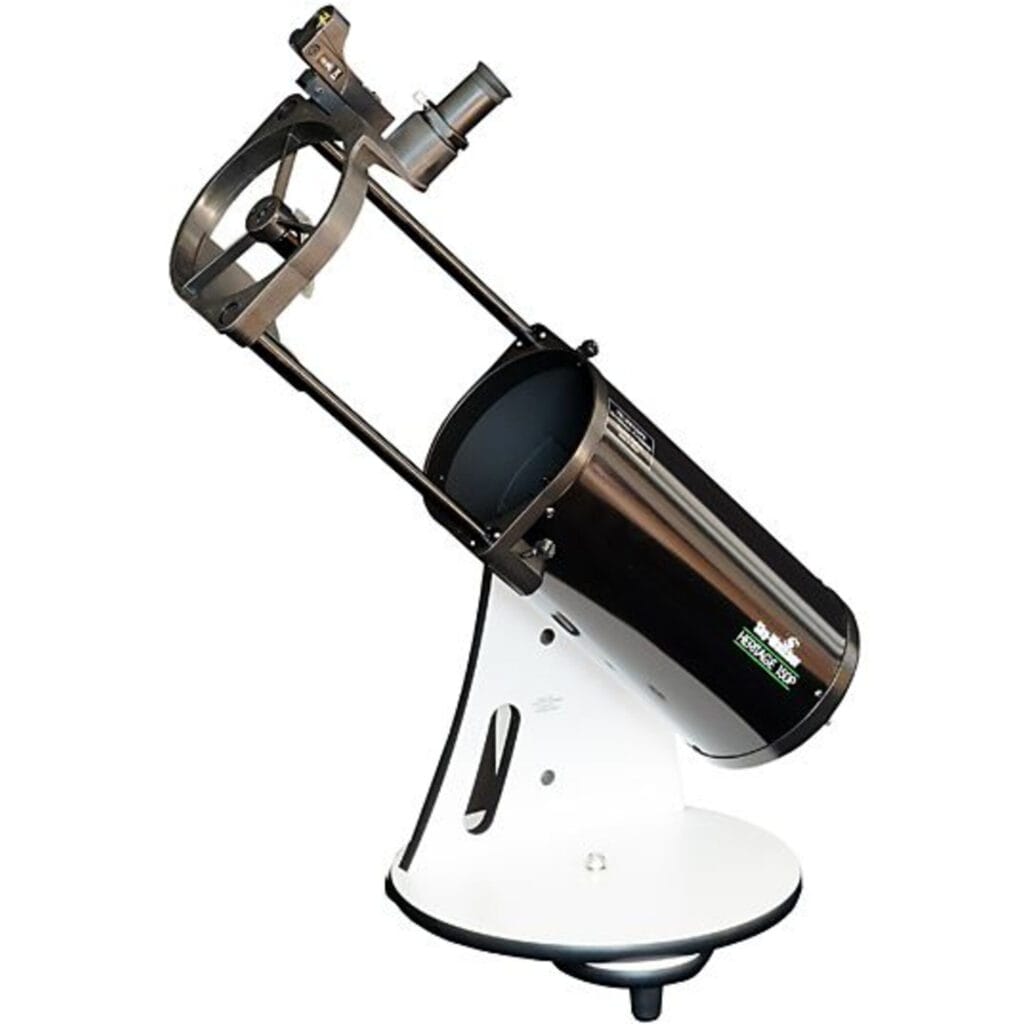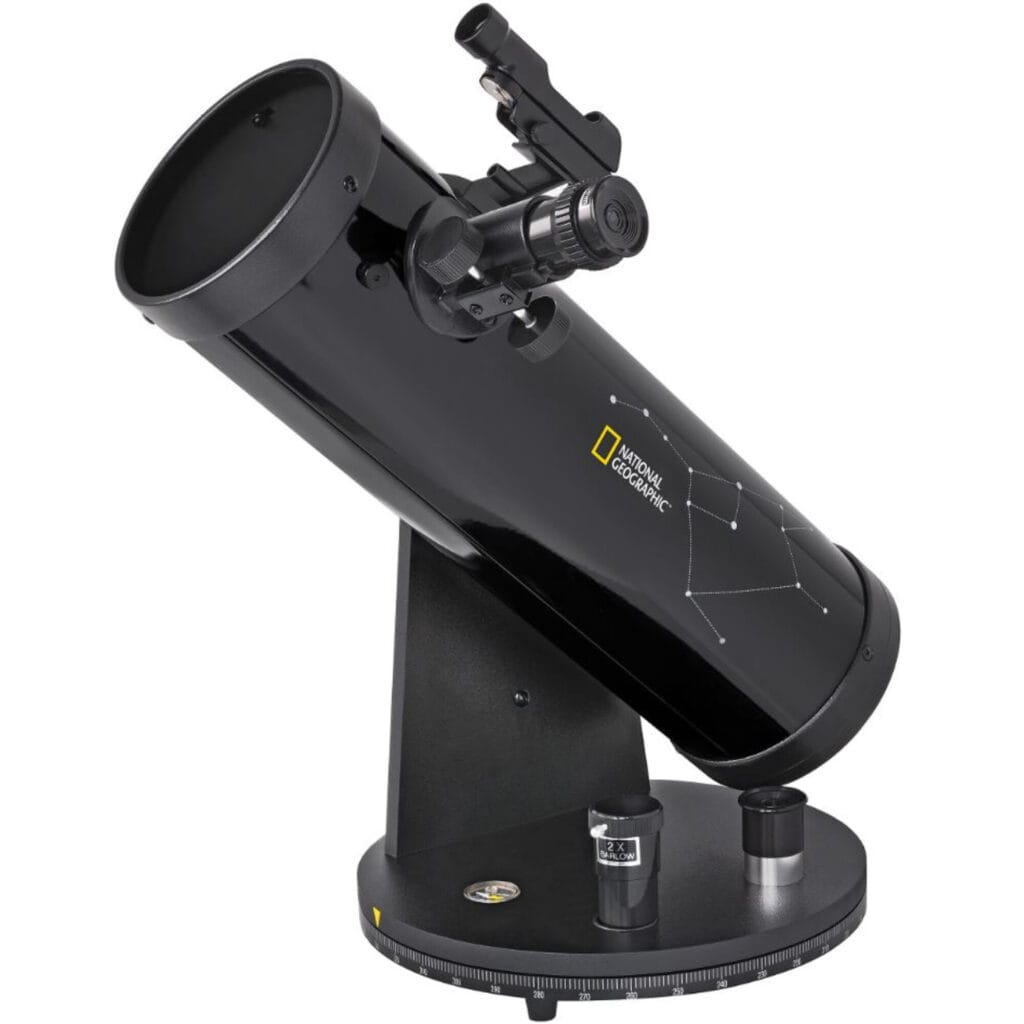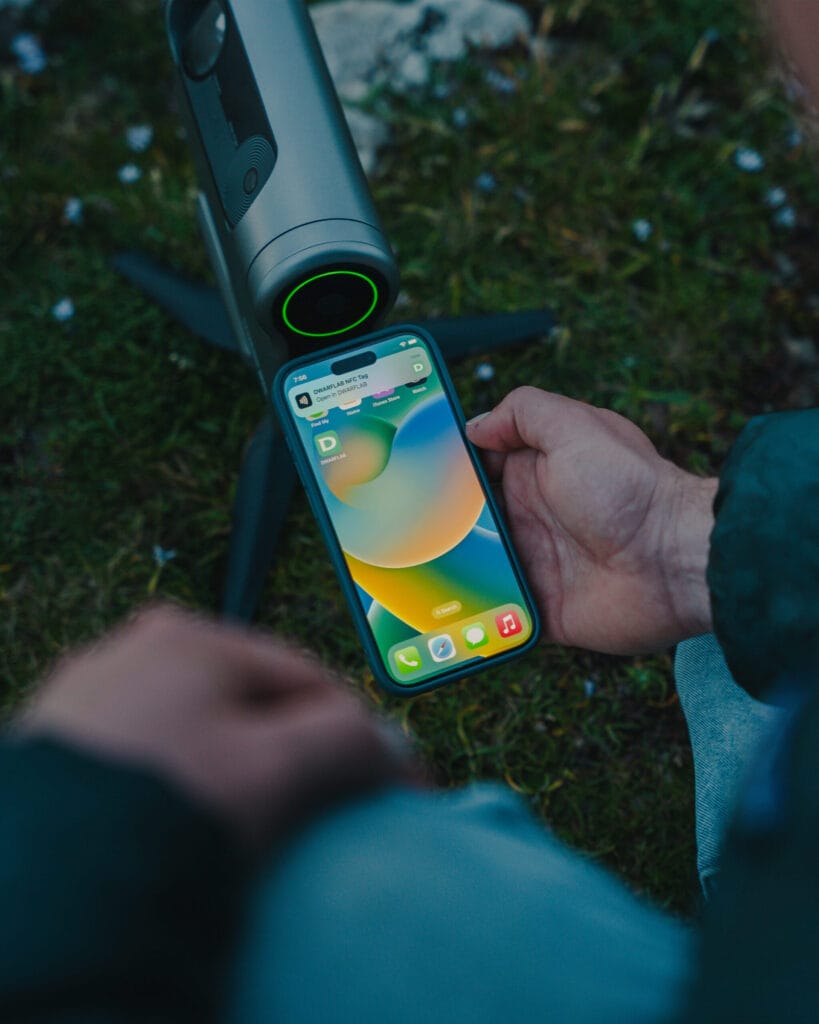Want to buy a telescope but not sure which one suits you? Don't worry, our digital telescope expert AstroBob will help you personally. He's powered by knowledge from our own specialists, so you'll get the same advice as if you asked us directly. Whether you're unsure about the right aperture, have questions about astrophotography, or want to know what you can see with a specific model - ask your questions via live chat.
➡️ Click in the bottom right to chat with AstroBob directly.
Prefer to explore on your own?
With our interactive selection guide, you'll discover which telescope matches your needs in just 2 minutes.
Our Personal Recommendations
We understand that choosing can be difficult, so we're happy to help you move forward. Below you'll see which telescope we recommend based on your situation:
Beginning Observer (Adult or Older Child)
Looking for a sturdy telescope that's easy to set up and great for viewing the moon and planets?
Recommended model:
Sky-Watcher Dobsonian telescope N 130/650 Heritage FlexTube DOB
✓ Excellent for beginners
✓ Easy to use
✓ Ideal for moon, Jupiter and Saturn and famous galaxies/nebulae like Andromeda and Orion
✓ Sturdy and stable image

Young Children (6-10 Years)
Want to discover the moon or Jupiter with your child without complicated setup?
Recommended model:
National Geographic Dobsonian telescope N 114/500 Compact
✓ Light weight, compact design
✓ Fixed Dobsonian base (not wobbly)
✓ Ready to use out of the box
✓ Safe, child-friendly entry level

Want to Take Photos Too?
Interested in astrophotography of the moon, star clusters, or planets?
Recommended option:
A smart scope like the Seestar S50 or DWARF 3 automatically takes sharp photos and tracks objects in the sky. Ideal for beginners without technical knowledge. Read in our blog Seestar vs. Dwarf 3 which one to choose.

Planets and Photography?
Want to both observe and photograph with good results?
Recommended bundle:
Bresser 70/700 bundle for moon and planets
✓ Including filters for better planetary details
✓ Includes tripod, accessories and Barlow lens
✓ Suitable for entry-level astrophotography
Still not Sure? Read on!
Which Telescope should I Buy?
Choosing the right telescope starts with a simple question: what do you want to do with it? Not every telescope is suitable for the same use. Do you mainly want to observe the Moon and planets, or are you interested in faint deep-sky objects like galaxies and nebulae? Or do you want to take photos of the sky?
Your experience also plays a major role. Beginners benefit from simple models with a stable setup, while advanced users often look for more capabilities or larger optics.
Another important aspect is location: are you observing from a city, or do you have access to a dark site? This determines how much light pollution you need to compensate for with aperture and image quality.
Which Telescope is Good for Beginners?
A good telescope for beginners is easy to use, gives quick results, and has a sturdy mount. Dobsonian telescopes or smart telescopes are very suitable to start with. They require little maintenance, are easy to set up, and ideal for viewing the moon and bright planets. Smart telescopes even track the object automatically.
Compact reflectors like a Newton 114/900 on a simple equatorial mount are also popular. They offer more aperture for a lower price, which helps when viewing deep-sky objects under dark skies. If you want to take photos, an EQ telescope helps. You align it and it compensates for Earth's rotation, making your deep sky observations even better.
Consider these points when buying your first telescope:
✓ The telescope must be stable
Choose a model with a solid base: a Dobsonian or thick aluminum tripod. Wobbly models ruin your experience especially at higher magnifications.
✓ You must be able to aim easily
Make sure the telescope has a tool for finding objects in the sky. A finder scope or red dot finder is essential - without it, even finding the moon is difficult.
✓ No exaggerated magnification
Don't fall for claims like “675x magnification!”, they're misleading. The maximum useful magnification is approximately 2x the lens aperture in millimeters.
So a telescope with 70 mm aperture? → Maximum useful magnification around 140x.
A telescope with 150 mm? → Then 300x can indeed be achievable - provided the optics are good and the air is stable.
✓ You should be able to get started quickly
A beginner's model should be set up within 10 minutes. No complicated assembly, no mirror alignment. Set up, aim, observe.
✓ Wide enough field of view to find something
Too high magnification makes it difficult to get something in view. Start with a 20-25 mm eyepiece, which gives a comprehensive view to learn navigation.
A telescope that sets up in 10 minutes and gives immediate results provides motivation to discover more.
What's a Good Telescope for Viewing Planets?
Want to see Saturn's rings, Jupiter's moons, or craters on the moon?
Then you need a telescope that:
✓ Can magnify enough
✓ Stays sharp at that magnification
✓ Stands stable so the image doesn't move
Good Choices for Planet Viewing:
- Models with a longer tube: they magnify more easily without the image becoming blurry
- Sturdy mount: telescope shouldn't vibrate when touched or focused
- Minimum 70 mm lens or 114 mm mirror: then you'll really see details like rings or moons
- With included eyepieces around 10 mm: these are suitable for higher magnifications
What to Expect:
- The Moon: craters, mountains, shadows
- Jupiter: four major moons, cloud bands
- Saturn: rings and sometimes a moon
- Mars: in good conditions you can see polar caps or color differences
Also check if the telescope has an aiming aid, like a red dot finder or small finder scope ... otherwise it's difficult to get anything in view.
Which Telescope is Good for Deep-Sky Objects?
Deep-sky objects like star clusters, nebulae, and galaxies are often very faint. Therefore, you need a telescope that captures as much light as possible. For this, one thing is important: the aperture of the telescope (the diameter of the mirror or lens).
The larger the aperture, the better you'll see these faint objects.
Good choices for deep-sky viewing are:
✓ Newtonian reflector telescopes from 130 mm aperture
Especially when mounted on a Dobsonian mount. You get great value for money and they're ideal for star clusters and nebulae under dark skies.
✓ Schmidt-Cassegrain telescopes from 200 mm aperture
Compact, powerful and suitable for those looking for more than an entry-level model.
✓ Telescopes with wide field of view
Models that show a large portion of the sky at low magnification are useful for finding large objects like the Andromeda galaxy. You can recognize them by terms like “suitable for wide fields” or included eyepieces of 25 mm or more.
Note: in a city with heavy light pollution, deep-sky objects are often less visible, even with a powerful telescope. The darker the environment, the more you'll see.
What Types of Telescopes are there?
There are three main types of telescopes, each with their own advantages and disadvantages:
- Refractor (lens telescope)
- Uses lenses to focus light
- Closed tube, requires little maintenance
- Excellent for the Moon, planets and double stars
- Disadvantage: chromatic aberration in cheaper models
- Reflector (mirror telescope, Newton)
- Uses mirrors to collect light
- Large aperture for relatively low price
- Ideal for deep-sky objects under dark skies
- Open tube, requires occasional collimation (alignment)
- Compound telescope (Maksutov or Schmidt-Cassegrain)
- Combines mirrors and lenses
- Compact design with long focal length
- Versatile for visual use and photography
- Slightly more expensive, but very popular with advanced users
The choice depends on your goals, budget, and experience. Beginners often start with a refractor or small reflector. Those wanting to see or photograph more typically end up with a larger Newton or compact Schmidt-Cassegrain.
Can I Take Photos with a Telescope?
Yes, you can - but not equally easy with every model. Astrophotography requires stability, accurate tracking, and often additional accessories like adapters, cameras, or even tracking mounts. There are two routes:
- Smart telescopes like the Seestar S50, DWARF 3, or Vespera automatically take stacked photos with surprisingly good detail, without technical knowledge.
- Manual systems where you connect a DSLR or astrocam to a telescope with equatorial mount. These require more experience but offer maximum control and quality.
Note that not every telescope is suitable for this. Many beginner models are purely meant for visual use. If you want to take photos, make sure the mount supports astrophotography.
I Want to Track Objects, How Do I Do That?
The mount determines how you move and track the telescope. There are two main types:
Altazimuth mount
- Moves in horizontal and vertical directions (like a photo tripod)
- Simple to use, ideal for beginners
- Less suitable for astrophotography due to field rotation
Equatorial mount
- Tracks Earth's rotation with one axis
- Suitable for accurate tracking of objects in the sky
- Better for astrophotography, but requires more explanation
For purely visual use, an altazimuth mount is fine. If you want accurate tracking or photography, then an equatorial mount is a better choice.
